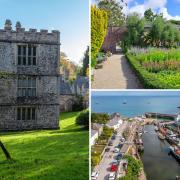The Newlyn School art colonies captured Cornish people and their everyday way of life - rediscover it at Penzance's Penlee Gallery

Capturing Cornwall The Newlyn School art colonies captured Cornish people and their everyday way of life - much of which has now disappeared. EWEN MACDONALD rediscovers it at the Penlee House Museum's outstanding permanent collection
As I meander through the park I can here the rustling of the leaves in the mild wind and the sound of tennis balls springing off taut strings and I’m instantly transported to 1966’s Blowup, every photographers’ favourite vanity film.
Penlee House is nestled in a glorious little spot in Penzance, resplendent with tropical shrubbery and an art collection which itself has its own beguiling web to weave.
Samuel John Lamorna’ Birch’s January, the Mill at Lamorna, oil on canvas painting is a gloomier and denser picture than much of the collection. Its thick impasto oils give heart to the Cornish countryside with its deep browns and greens and the mild peppering of blue from the sky. It displays a thicker, harder, more, in-yer-face, pastoral scene than one of Constable’s. Yet the paintwork seemed, rather implausibly, like a link between Constable’s landscapes to one of Peter Doig’s primordial woods.
The title of Richard Copeland Seal’ Weatherby’s Stanley Gardiner (1945) may as well have been A Portrait of the Artist as Heroic Painter. The artist in question stands poised for battle with his canvas, pallet and paintbrush in his hand, his sleeves rolled up, his forearm muscles rippling, the fierce summer sun beating down. Juxtaposed to this demeanour, his face is calm and contemplative, a stroke of the paintbrush having just departed the canvas. The brush and his pipe lie languid in his hand and mouth as the stalwart thighs and calves grip the harsh soil of the landscape he has settled in to paint en plein air.
Myrtle Cottage (1948) is a wonderful work by Adrian Ryan. With its mildly expressionistic oils rendering the curling, swirling greens of exotic plant life seemingly alive. Behind this rampant foliage are buildings imprisoned by nature, the reds of a chimney stack and the gable end of a house play violently off against the greens, giving the piece a riotous dissonance added to which the blue and white of the sky tell of an amassing passion. This is a small painting of great beauty and by an old Etonian no less (how thoroughly contemporary). Ryan also studied at the Slade School of Art and the Architectural Association in London. Wow! An education doesn’t get more exclusive than that. It’s just as well he can paint then.
In the hallway on the first floor is Garstin Cox’s Departing Day Cornwall. An elegiac oil on canvas, especially given the melancholic weight of its title. The landscape is lit up in a glow of mournful pinks, making their way across the landscape towards the turquoise of the sea. This painting tells us so much about the breathtaking beauty of Cornwall away from the raging currents and howling winds, the lashing rain and the crashing waves. Cornwall is constructed of so many parts which are greater than their sum. To truly know Cornwall’s topography, beauty and danger is to live through it all daily, including those heartrending moments of dawns and dusks, sunrises and sunsets, or as photographers have it the golden hours’.
It is impossible to miss or not be charmed by Dame Laura Knight’s Flying a Kite (1909-10). A group of children are perched atop of a hill, with a view over Newlyn towards Penzance, on the perfect outing, which of course means adults are excluded. In the foreground of the oil painting are nine kids flying a kite and Knight captures each of the children in their own pose. It’s a windy day with a rainbow shining high in the sky, but the artist avoids whimsy. There are some pensive faces, while one young girl convulsively shields her face from the wind. There are also other expressions on display, some amused and some calmly concentrating. The artist captures a period that was passing even as she painted it. A Railway Children’ type Edwardian idyll soon to be shattered by war. The two young boys in the picture, perhaps now buried beneath the fields of the Somme or Paschendale.
Elizabeth Azela Forbes’ A Zandvoort Fishgirl (1884) shows a pretty, wan, Dutch teenage girl who, in other circumstances, may have been a great portrait of a young ingénue. Her striking, mildly arrogant pose wouldn’t look so far out of place in a current Vogue shoot, a very outré photo assignment of course, given her apron and the bowl of fish in her hands.
In close proximity to that work is Thomas Cooper Gotch’s Ruby (c. 1908-9), an oil on canvas painting depicting the ringlets and cherubic Renaissance face of a young girl who stares innocently yet stoically towards us. Details are everything in a painting, it’s what makes them great and in this particular one the red cape, including a marbled button, is magnificent. Though it’s difficult not to look at a garment so red and not think of Nicholas Roeg’s 1973 chiller, Don’t Look Now, itself taken from that famous Cornish resident Daphne du Maurier’s short story of the same title.
Walter Langley Cornish Fisherfolk (1908) is a wonderfully three dimensional work, the foreground all sharp focus, working its way with receding shallowness of field to the back of the picture. It is a photographic rendering in that this is the way a lens works, not the human eye. It depicts a typical Cornish street scene containing both old and young and a mother trapped between these two stages of life.
The first notable remark to make about Norman Garstin’s The Rain it Raineth Every Day (1889) is that this renowned painting was once hidden because it was felt it put Penzance in a bad light for tourists. I admire the great courage of Garstin in painting so much rain skimmed blank space as the central focus of the composition. The wet, the rain, the water and the waves are so palpable as to make the mouth dry and long to be cooled. It’s a fine joke too for a Cornish resident. It certainly can rain here, though not as much as the Scottish Highlands I fancy. In spite of its subject matter this is actually a bright, sharp picture with a hint of impressionism and despite its gloomy bearing it is still light filled. As anyone fortunate enough to live here can attest Cornwall has a terrific light and nowhere more so than in Penwith.
Penlee House Gallery and Museum, Morrab Road, Penzance TR18 4HE
Admission: £4.50 adults / £3 concessions /under 18s FREE.
penleehouse.org.uk
The Newlyn School
The Newlyn School stretches from 1880 to 1940 and incorporates different artists. The first began in the 1880s when artists Walter Langley arrived, soon followed by Stanhope Forbes. Within a few years there were almost 30 artists living and working in or around Newlyn, St Ives, Falmouth and Lelant. Many had trained in Paris and worked in the South of France. The artists were attracted to the fantastic light, cheap living, and the availability of inexpensive models in the fishermen and their families and their working life at sea and the everyday life in the harbour and nearby villages. Some paintings showed the hazards and tragedy of the community’s life, such as women anxiously looking out to sea as the boats go out, or a young woman crying on hearing news of a disaster. Many fascinating elements to Cornish harbour life were recorded in their paintings. When fishing boats went missing a telegram was sent to Newlyn Post Office and put up on the wall where families would discover the names of the missing. Newlyn fishermen also rioted when fishermen from elsewhere turned up to fish in their waters. Other artists include Alfred Munnings, Dame Laura Knight, her husband Harold and Walter Langley.
At the turn of the century, Stanhope and Elizabeth Forbes founded their School of Painting, bringing a new generation of artists to Newlyn, including Dod and Ernest Procter and Frank Gascoigne Heat.
This article first appeared in April 2015 Cornwall Life



























